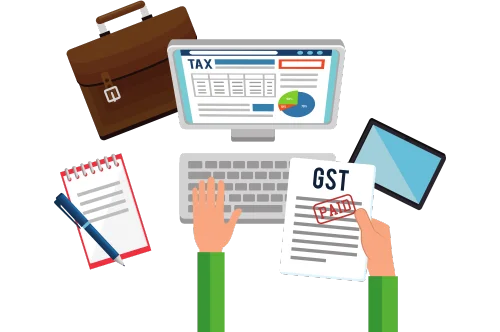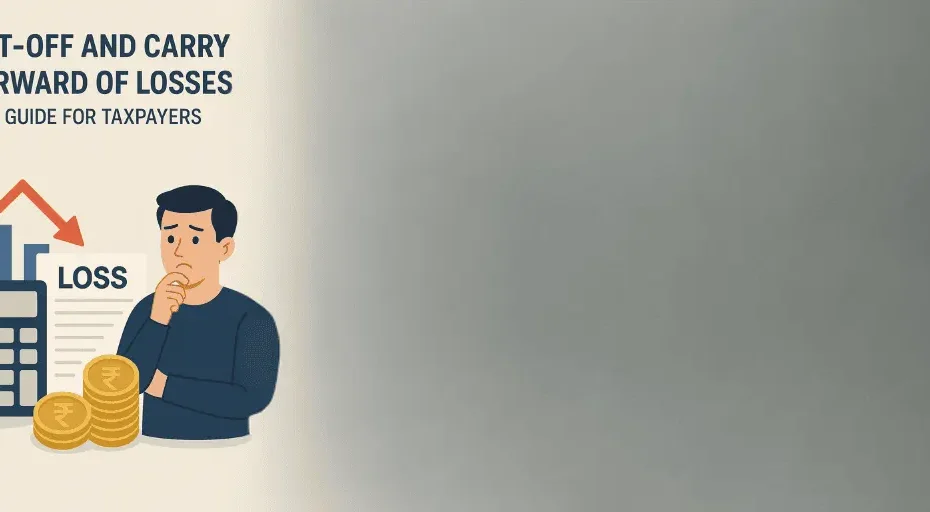Set-Off and Carry Forward of Losses: A Guide for Taxpayers
In the world of taxation, profits and losses go hand in hand. While paying taxes on profits is inevitable, taxpayers can reduce their tax liability by utilizing the mechanism of set off and carry forward of losses. This legal provision under the Income Tax Act, 1961 offers a strategic advantage to both individuals and businesses to optimize their tax outgo.
In this comprehensive guide, we’ll explore what set off and carry forward of losses means, how it works, the types of losses covered, and the conditions that must be met for availing its benefits.
What Is Set-Off of Losses?
The term “set-off” refers to adjusting a loss incurred under one source of income against gains from another source in the same assessment year. For instance, if a taxpayer incurs a loss from a house property and earns profit from a business, the loss can be adjusted against the business income, subject to certain rules.
There are two kinds of set-offs:
Intra-head Set-Off
Loss from one source of income can be set off against income from another source under the same head.
Example: Loss from one house property can be set off against rental income from another house property.Inter-head Set-Off
Loss from one head of income can be set off against income from another head.
Example: Loss from house property can be set off against salary income.
However, not all losses are allowed for inter-head adjustments, and some are restricted. The set off and carry forward of losses is subject to specific conditions depending on the type of loss.
Carry Forward of Losses
If a loss cannot be fully adjusted in the same assessment year due to inadequate income, it can be carried forward to subsequent years. This is known as the “carry forward” of losses. The Income Tax Act allows such losses to be carried forward and set off in future years, subject to certain time limits and conditions.
Types of Losses and Their Treatment
1. Loss from House Property
Can be set off against any income head (including salary) in the same year.
If not fully adjusted, it can be carried forward for 8 years.
It can only be set off against income from house property in future years.
2. Business Loss (Non-Speculative)
Cannot be set off against salary income.
Can be set off against any other income (except salary) in the same year.
Can be carried forward for 8 years and set off only against business income.
3. Speculative Business Loss
Can only be set off against speculative income.
Can be carried forward for 4 years.
4. Capital Loss
Short-term capital loss (STCL): Can be set off against both short- and long-term capital gains.
Long-term capital loss (LTCL): Can only be set off against long-term capital gains.
Both can be carried forward for 8 years.
5. Loss from Owning and Maintaining Race Horses
Can be carried forward for 4 years.
Can only be set off against income from the same activity.
6. Unabsorbed Depreciation
No time limit for carry forward.
Can be set off against income from any head (except salary).
Understanding the nuances of these loss types is crucial to make the best use of set off and carry forward of losses provisions.
Conditions for Carry Forward of Losses
To claim set off and carry forward of losses, the following conditions must be met:
Timely Filing of Return
Losses (except loss from house property) must be declared in the income tax return filed within the due date under Section 139(1).Proper Documentation
The return must include relevant computation sheets and proofs to validate the losses.Same Assessee
Loss can only be carried forward and set off by the same person who incurred it (exceptions exist in cases like inheritance or firm succession).Same Head
Loss carried forward can generally be set off only against income from the same head in future years (except unabsorbed depreciation).
Strategic Tax Planning with Set-Off and Carry Forward
The set off and carry forward of losses provision is a powerful tax planning tool. Here’s how taxpayers can benefit:
Reduce Tax Burden in Profitable Years
Losses from previous years can be set off against current year’s gains, reducing taxable income.Cash Flow Management
Businesses experiencing cyclic income patterns can manage their cash flow better by offsetting lean period losses.Encourage Risk-Taking and Investment
Especially for startups and capital market investors, the allowance to carry forward capital and business losses promotes entrepreneurial risk-taking.
Common Mistakes to Avoid
Missing Return Deadlines
Losses (except house property loss) are not allowed to be carried forward if the return is filed after the due date.Incorrect Classification of Losses
Misclassifying speculative vs. non-speculative business income can lead to wrong set-off claims.Failure to Track Expiry Period
Different losses have different carry forward periods. Taxpayers must track and utilize them before they lapse.Ignoring Clubbing Provisions
In some cases, income is clubbed with that of a spouse or minor child. Ensure losses are accounted for correctly in such scenarios.
Conclusion
Understanding the rules of set off and carry forward of losses can help taxpayers minimize their tax liability and plan effectively for the future. Whether you’re an individual taxpayer, a salaried employee with a home loan, a stock market investor, or a business owner, this provision can make a significant difference in your overall tax planning strategy.
Ensure accurate classification of losses, adhere to deadlines, and consult a tax professional to make the most of the benefits available under the set off and carry forward of losses. With careful planning and awareness, this legal provision can serve as a robust shield against fluctuating income and unpredictable profits.
Our GST Services

All E-commerce Tax services
E-commerce tax services help online sellers navigate GST registration, compliance, return filing, TCS management, tax planning, and audits, ensuring efficient tax management and legal compliance.

GST Filing
GST filing is the process of submitting tax returns to the government, detailing sales, purchases, and taxes paid or collected, ensuring compliance with GST laws.

GST Registration
GST registration is the process where businesses obtain a GSTIN from the government, allowing them to collect taxes, claim input tax credits, and comply with GST laws.





